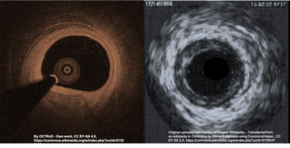Spontaneous coronary artery dissection
| Spontaneous coronary artery dissection | |
|---|---|
| Other names | Coronary artery dissection, SCAD |
Spontaneous coronary artery dissection (SCAD) is an uncommon but potentially lethal condition in which one of the coronary arteries that supply the heart, spontaneously develops a blood collection, or hematoma, within the artery wall due to a tear in the wall. SCAD is one of the arterial dissections that can occur.[1]
SCAD is a major cause of
Signs and symptoms
SCAD often presents like a
Causes
Risk factors include pregnancy and the
Pathophysiology
SCAD symptoms are the result of a restriction in the size of the lumen of the affected coronary artery. A bleed within the wall of the artery (tunica intima) originating from the microvessels that perfuse this muscular layer (vasa vasorum) leads to a collection of blood, or hematoma, between the layers of the artery wall.[1] The hematoma pushes close the lumen, preventing blood from flowing to the heart muscle (

Involvement of the Vasa Vasorum
While the molecular mechanisms that underpin SCAD are still poorly understood, studies have implicated dysfunction of the
Genetics
It is likely that both genetics and environment play a role in SCAD onset. A number of genetic variants have been linked to an increased the risk of SCAD. As with
Diagnosis

Given the demographics of SCAD, it is important to maintain a high index of suspicion for the condition in otherwise low-risk women presenting with symptoms of
With typically elevated cardiac biomarkers and ECG changes, people will often undergo
Angiography
There are 3 types of SCAD based on angiographic and anatomical criteria; with the designations based on the location and extent of the hematoma within the walls of the coronary arteries.
Intracoronary imaging

Intracoronary imaging (ICI), consisting of
Other methods
Some studies propose coronary CT angiography to evaluate SCAD in lower-risk people, with research into the approach ongoing.[4][17]
Management
Management depends upon the presenting symptoms. In most people who are hemodynamically stable without high-risk coronary involvement, conservative medical management with blood pressure control is recommended.[4][20][21] In these people, especially if angiography demonstrates adequate coronary flow, the most likely course usually leads to spontaneous healing, often within 30 days.[22] Anti-coagulation should be discontinued upon diagnosis of SCAD on coronary angiography as continuation of anti-coagulation may lead to hematoma and dissection propagation.[18]
In cases involving high-risk coronaries, hemodynamic instability, or a lack of improvement or worsening after initial attempts at treatment, urgent treatment with
Physical stress is associated with SCAD recurrence but there are no heart rate, blood pressure or weight exercise parameters that are established in those with SCAD. In general, it is recommended that those with SCAD avoid
After addressing the SCAD, people are often treated with typical post-heart attack care, though people who are pregnant may need altered therapy due to the possibility of some
Prognosis
People with SCAD have a low in-hospital mortality after treatment. However, the lesion may worsen after leaving the hospital within the first month.[17][25] One study suggested a 1.2% mortality rate following SCAD but a 19.9% risk for either death, heart attacks, or strokes.[26] Even afterwards, SCAD has a high recurrence risk at 30% within 10 years, often at a different site than the initial lesion - meaning that stents placed in the location of the first lesion may not protect against a second.[17] Given the lack of consensus on the cause of SCAD, prevention of future SCAD may include medical therapy, counseling about becoming pregnant again (for those who had pregnancy-associated SCAD), or avoidance of estrogen therapy.[citation needed]
Preventative Research
Research is currently being carried out to identify what causes SCAD, in an effort to prevent recurrence, or potentially onset in at risk family members of SCAD patients. Australian researchers at the Victor Chang Cardiac Research Institute, for example, have generated induced pluripotent stem cell (iPSC) lines from patients to model SCAD 'in a dish'. [27]
Epidemiology
SCAD is the most common cause of
History
SCAD was first described in the year 1931, at postmortem examination, in a 42-year-old woman.[29][28] Due to a lack of recognition and diagnostic technology though, SCAD literature until the 21st century included only case reports and series.[28] With the recent advent of coronary angiography and intracoronary imaging, recognition and diagnosis of SCAD has greatly increased, especially in the 2010s.[28]
See also
- Dissection (medical)
- Aortic dissection
- Kounis syndrome
References
- ^ PMID 36561772.
- ^ "Spontaneous Coronary Artery Dissection Postpartum"
- ^ "Symptoms and causes - Mayo Clinic". www.mayoclinic.org. Retrieved 2018-11-07.
- ^ PMID 29472380.
- PMID 32713767.
- ^ Dhawan R, Singh G, Fesniak H. (2002) "Spontaneous coronary artery dissection: the clinical spectrum". Angiology
- ^ Mark V. Sherrid; Jennifer Mieres; Allen Mogtader; Naresh Menezes; Gregory Steinberg (1995) "Onset During Exercise of Spontaneous Coronary Artery Dissection and Sudden Death. Occurrence in a Trained Athlete: Case Report and Review of Prior Cases" Chest
- ^ "Spontaneous coronary artery dissection (SCAD) - Symptoms and causes". Mayo Clinic.
- PMID 32713767.
- ^ Virmani R, Forman MB, Rabinowitz M, McAllister HA (1984) "Coronary artery dissections" Cardiol Clinics
- ^ Kamineni R, Sadhu A, Alpert JS. (2002) "Spontaneous coronary artery dissection: Report of two cases and 50-year review of the literature" Cardiol Rev
- PMID 18830003.
- ^ PMID 35583931.
- ^ PMID 30487978.
- ^ C. Basso, G. L. Morgagni, G. Thiene (1996) "Spontaneous coronary artery dissection: a neglected cause of acute myocardial ischaemia and sudden death" BMJ
- PMID 1449336.
- ^ PMID 31275818.
- ^ S2CID 228087493.
- ^ Intravascular Ultrasound Imaging in the Diagnosis and Treatment: The Future: IVUS-Guided DES Implantation?
- ^ "Coronary Artery Dissection: Not Just a Heart Attack". www.heart.org. Retrieved 2018-11-07.
- ^ "SCAD: Not Your Typical Heart Attack".
- PMID 23078737.
- ^ MedHelp:Coronary artery dissection treatment
- PMID 25406203.
- ^ PMID 30684142.
- PMID 28838364.
- .
- ^ PMID 27417009.
- S2CID 220036709.
